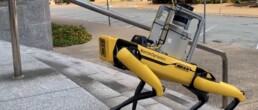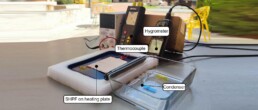Research + Breakthroughs
Six standouts in 2023
by Nat Levy
SCROLL ↓
Research is at the core of the Cockrell School of Engineering.
These world-changing breakthroughs make the Cockrell School one of the primary engines of innovation at UT Austin. Texas Engineering researchers are exploring some of the biggest problems imaginable. They’re learning more about the fundamental building blocks of life, developing new energy solutions, setting up the future of computing, finding new ways to care for our environment and breaking ground in the development of our transportation infrastructure. Here are just a few of the many examples of impactful research breakthroughs from Cockrell School researchers over the last year or so.
Plastic-Eating Enzyme
Landfills around the world are packed to the brim with billions of tons of plastic that will take decades to degrade if they ever do. Efforts to deal with this plastic problem got a jolt when Texas Engineers demonstrated a new enzyme that in 24 hours can break down a type of plastic called polyethylene terephthalate (PET), a significant polymer found in most consumer packaging, including cookie containers, soda bottles, fruit and salad packaging, and certain fibers and textiles. It makes up 12% of all global waste. The enzyme was able to complete a circular process
of breaking down the plastic into smaller parts (depolymerization) and then chemically putting it back together (repolymerization).
Electronic Tattoos
The Cockrell School in recent years has become a global leader in the development of electronic tattoos, which are soft wearable devices with integrated sensors that comfortably attach to the wearer’s skin and transmit data wirelessly. These devices have tremendous potential in health care, where they can provide continuous, mobile monitoring outside of the clinical setting. Building on years of e-tattoos breakthroughs, Texas Engineers have created several exciting e-tattoos in just the last few months: one that monitors blood pressure, another that applies to the palm and can tell when you’re stressed out, one that is implanted directly on the heart surface that functions like a pacemaker and another that attaches to the chest to monitor important heart signals.

Robots in the Wild
An interdisciplinary project that features personnel from several different colleges and schools at UT Austin will deliver the largest study yet of human-robot interactions in public spaces. They will develop a robot delivery network to drop off basic supplies around campus. The robots will be taught to navigate busy public areas and complex routes from building to building. As part of the project, the researchers will talk to people who encounter the robots. This work could help designers figure out how future public-facing robots should be designed to co-exist within diverse communities like UT Austin’s, as well as how and where they should move.
Heating and Cooling Mattress
Researchers developed a unique mattress and pillow system that uses heating and cooling to trick the body into falling asleep faster. Sleep is possible when the body temperature declines at night as part of the 24-hour rhythm. This new mattress stimulates the body to trigger the sleepy feeling, helping people fall asleep faster and improving the quality of sleep. The skin of the neck is an important bodily thermostat for humans, and it is the primary sensor the mattress targets, with a warming pillow. The mattress is designed to simultaneously cool the central areas of the body while heating the neck, hands and feet, thereby increasing blood flow to dissipate body heat.

Hydrogels Can Pull Water from Air
A recently developed low-cost gel film made of abundant materials can pull water from the air in even the driest climates. That could be a major boon to more than a third of the world’s population living in drylands, areas that experience significant water shortages. The research builds on previous breakthroughs from the team, including the ability to pull water out of the atmosphere and the application of that technology to create self-watering soil. However, these technologies were designed to work in relatively high-humidity environments. The film is flexible and can be molded into a variety of shapes and sizes, depending on the need of the user. And it can be made from low-cost, abundant materials, with a simple process that many at-home users could follow with basic instructions.
First-ever Global River Database
Rivers are dynamic parts of our ecosystem, shifting over time to remain healthy. Texas Engineering researchers created the first-ever database that tracks these changes. The database uses publicly available remote sensing data to show how the river centerlines of the world’s 48 most threatened river deltas have moved during the past 40 years. The data can be used to predict how rivers will continue to move over time and help governments manage population density and future development. The database includes three U.S. rivers, the Mississippi, the Colorado and the Rio Grande. Although some areas of these deltas are experiencing movement, overall, they are mostly stable, the data show. Aggressive containment strategies to keep those rivers in their place, especially near population centers, play a role in that.